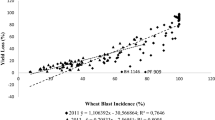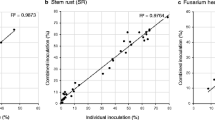Abstract
Nineteen cultivars, with large differences in heading date, were evaluated for their response to septoria tritici blotch in two experimental setups in Njoro, Kenya. Due to the more or less constant temperatures during the growing season and the overhead irrigation applied the epidemic conditions were similar over the whole observation period for the early and late cultivars. In experiment 1 the cultivars were assessed for disease severity at the same moment irrespective of the developmental stage, while in experiment 2 the cultivars were assessed at the same developmental stage. Measured at the same time, the disease severity was highest in the early maturing cultivars and lowest in the late maturing cultivars (r = –0.78). When assessed at the same development stage the disease build up was independent of heading date (r = –0.10) but strongly dependent on resistance level. There were no indications that early heading cultivars were more susceptible than late heading cultivars.
Similar content being viewed by others
References
Arama, P.F., 1996. Effects of cultivar, isolate and environment on resistance of wheat to Septoria tritici blotch in Kenya. Thesis Wageningen Agricultural Wageningen, pp. 115.
Arama, P.F., J.E. Parlevliet & C.H. van Silfhout, 1994. Effect of plant height and days to heading on the expression of resistance in Triticum aestivum to Septoria tritici in Kenya. In: E. Arseniuk, T. Goral & P. Czembor (Eds), Proceedings of the 4th International Workshop on: Septoria of Cereals. July 4–7, 1994, pp. 153–157. IHAR Radzikow, Poland.
Camacho-Casas, M.A., W.E. Kronstad & A.L. Scharen, 1995. Septoria tritici resistance and associations with agronomic traits in a wheat cross. Crop Science 35: 971–976.
Danon, T., J.M. Sacks & Z. Eyal, 1982. The relationship among plant stature, maturity class, and susceptibility to septoria leaf blotch of wheat. Phytopathology 72: 1037–1042.
Eyal, Z., 1981. Integrated control of septoria diseases of wheat. Plant Disease 65: 763–768.
Eyal, Z., I. Wahl & J.M. Prescott, 1983. Evaluation of germplasm response to septoria leaf blotch of wheat. Euphytica 32: 439–446.
Eyal, Z., A.L. Scharen, J.M. Prescott & M. van Ginkel, 1987. The Septoria diseases of wheat: Concepts and methods of disease management. CIMMYT Publication, Mexico. 52 pp.
Jlibene, M., J.P. Gustafson & S. Rajaram, 1992. A field disease evaluation method for selecting wheats resistant to Mycosphaerella graminicola. Plant Breeding 108: 26–32.
King, J.F., R.J. Cook & S.C. Melville, 1983. A review of Septoria diseases of wheat and barley. Ann Appl Biol 103: 345–373.
Parlevliet, J.E., 1993. What is durable resistance, a general outline. In: Th. Jacobs & J.E. Parlevliet (Eds), Durability of Disease Resistance. pp. 23–39. Kluwer Academic Publishers, Dordrecht, The Netherlands.
Rajaram, S. & H.J. Dubin, 1977. Avoiding genetic vulnerability in semi-dwarf wheats. Ann NY Acad Sci. 287: 243–254.
Rosielle, A.A. & A.G.P. Brown, 1979. Inheritance, heritability and breeding behaviour of three sources of resistance to Septoria tritici in wheat. Euphytica 28: 285–392.
Rosielle, A.A. & W.J.R. Boyd, 1985. Genetics of host-pathogen interactions to the septoria species of wheat. In: A.L. Sharen (Ed), Septoria of cereals. USDA-ARS Publ. No. 12: 9–12.
Saari, E.E. & R.D. Wilcoxson, 1974. Plant disease situation of high yielding dwarf wheats in Asia and Africa. Ann Rev Phytopathology 12: 49–68.
Shaner, G. & R.E. Finney, 1982. Resistance in soft red winter wheat to Mycosphaerella graminicola. Phytopathology 72: 154–158.
Tottman, D.R. & R.J. Makepeace, 1979. An explanation of the decimal code for the growth stages of cereals, with illustrations. Ann Appl Biol 93: 221–234.
Van Beuningen, L.T. & M.M. Kohli, 1990. Deviation from the regression of infection on heading and height as a measure of resistance to septoria tritici blotch on wheat. Plant Disease 74: 488–493.
Author information
Authors and Affiliations
Rights and permissions
About this article
Cite this article
Arama, P., Parlevliet, J. & van Silfhout, C. Heading date and resistance to septoria tritici blotch in wheat not genetically associated. Euphytica 106, 63–68 (1999). https://doi.org/10.1023/A:1003593218761
Issue Date:
DOI: https://doi.org/10.1023/A:1003593218761




